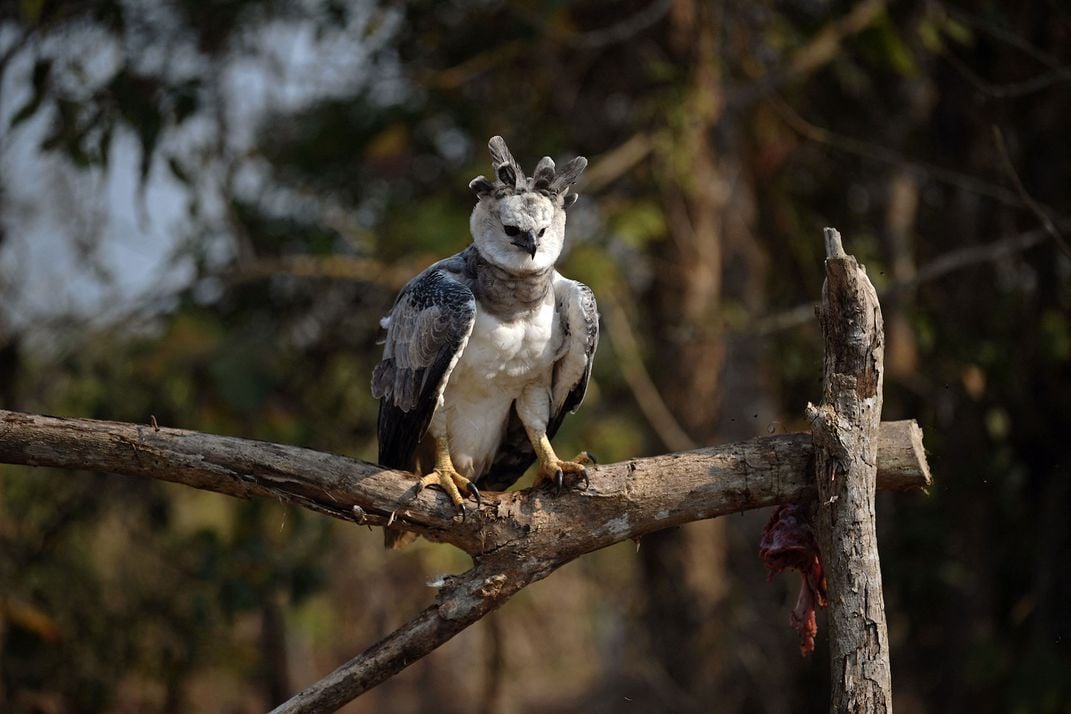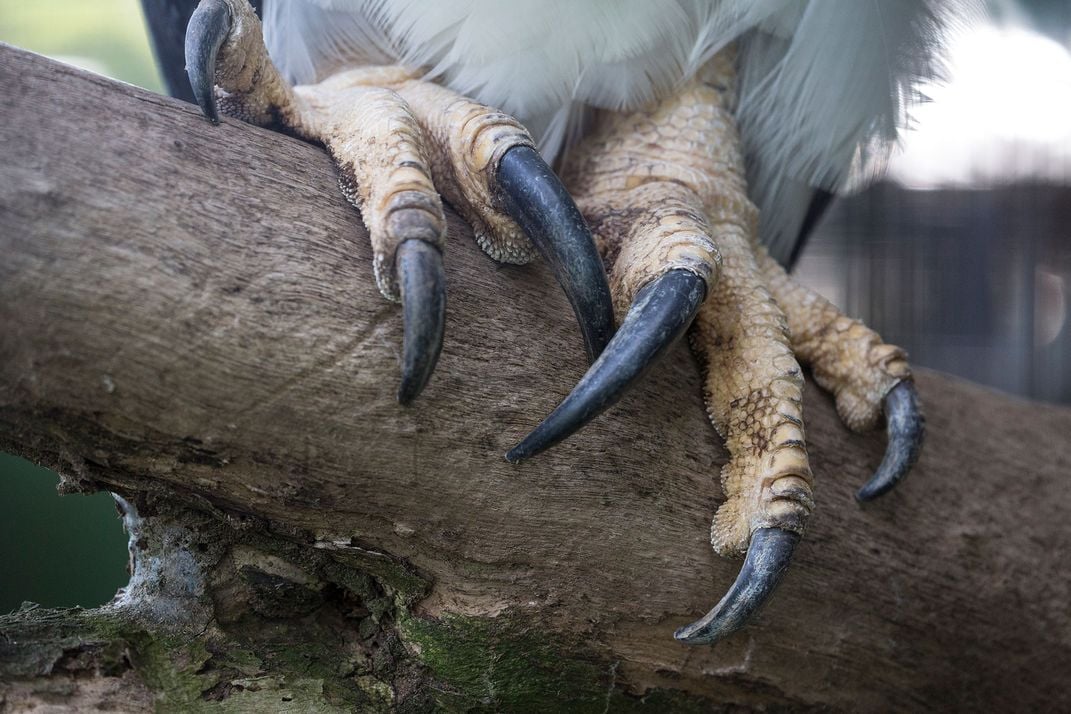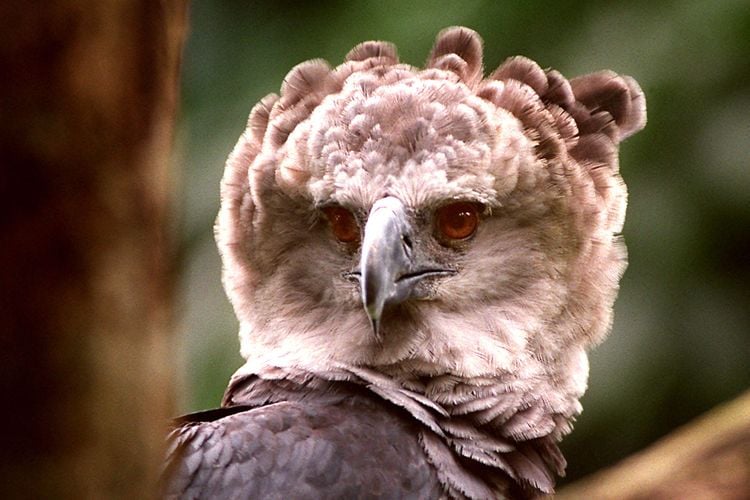Why Did a Large Harpy Eagle Attack an Adult Woman?
The incident, which took place in the forest in French Guiana, was an extremely rare occurrence

Bird-watching isn’t usually a dangerous game, even if it’s deep in the jungle of French Guiana. But when one woman strayed a little too far behind a tour group after spotting a large bird of prey, she ended up on the ground with a set of large talons gripping into her skull—the first scientifically documented person to be attacked in such a way by a wild harpy eagle.
Harpy eagles are among the heaviest raptors in the world, with larger females weighing up to an average of up to 20 pounds. They have a 6.5-foot wingspan and perhaps the largest talons of any birds at three to four inches long—about the size of a grizzly’s claws. If any bird of prey were going to take down a human, these would be the ones.
“We can’t go on telling people it’s not possible, because it is,” says Everton Miranda, an ecologist at Tohoku University in Japan.
Despite popular perceptions, wild eagle attacks of this severity on humans are incredibly rare. One of the few records of a possible predation is in the Taung Child remains—a fossilized Australopithecus africanus skull dating back 2.5 million years old that was found with puncture marks around its eye sockets similar to those made by modern eagle talons. The Taung Child’s remains were found alongside other smaller prey remains and eggshells in what may be a prehistoric raptor’s nest. Other records from old news sources in previous decades are less credible, for the most part, says Lauren McGough a falconer and cultural anthropologist who studies the relationships between humans and eagles.
The chance any eagle attacks a human is minute. “I would still put it like being struck by lightning—vanishingly small odds that that would happen to a person,” says McGough.

Quick fact: Where do harpy eagles live?
The raptors have been found from southern Mexico to northern Argentina, and they make their homes in forests at low elevations where prey and large trees are plentiful.As described in a paper published in April in Ecology and Evolution by Miranda and his colleagues, the attack occurred in October 2023 near an ecotourism camp along the Kourou River Basin in an area about 18 miles from the coast. A group of ten tourists and a guide were walking a trail toward a bathing area for people when they saw a harpy eagle perched on a branch about 20 feet high.
The eagle focused on the people, even bobbing its head as they took photos and watched. One 29-year-old woman, about 5 foot 6 and 114 pounds, walked back and forth on the path while taking photos. The rest of the group eventually left the woman and her partner behind. As the couple began to leave themselves, the adult eagle attacked, swooping in toward the woman. She immediately curled into a ball with her hands on her face as the eagle grabbed her skull in its talons.
The raptor stayed on top of her, even as the woman’s partner tried to free her. The bird didn’t let up until the man basically stomped its head down on the ground and held it there. Only then did the woman get free and run away. The eagle flew away, seemingly uninjured—and people could hear it calling for some time.

Miranda says that it’s possible that the eagle was hunting. In the study, he notes that a primate had been killed in the area in recent days, possibly by the eagle. Also, just before the group saw the eagle, they were surprised by a paca—a large, usually nocturnal rodent—on the trail. The tourists may have interrupted the eagle while feeding on the primate or while hunting the paca, prompting the raptor to attack in defense of its prey. “It seems like the eagle was hungry, in hunting mode, and was interrupted by a primate,” he says.
The eagle’s intent watching of the tourists might have foreshadowed the aggression, Miranda says. “This head-bobbing behavior means that the animal is measuring distance,” he says—a common method they use to evaluate whether it’s worth attacking.
McGough says the best thing to do with an eagle exhibiting that kind of behavior is to give it a wide berth rather than stopping to take a lot of pictures. “There are still wild things out there that you have to be cognizant and careful of,” she says.
The eagle may have just seen these humans as another primate—a common food item, though their main prey is usually sloths, Miranda says. While he didn’t write about it in the study, Miranda has heard of four other cases of harpy eagles attacking people, often smaller people or children. None of these resulted in a death—of the humans, at least. In one case, someone nearby came to the aid of the victim, killing the eagle with a machete. The grip of the raptor’s talons was so strong that they stayed latched on the victim’s hand even after death—people had to chop off the eagle’s leg and remove the talons in the hospital, Miranda says. The woman in French Guiana made it to a hospital and was treated for her wounds on her scalp.
“When you look at the folklore of the Indigenous people in South America, they see this bird as a predator that may kill kids, that may attack old people,” he says. “It’s very rare but not rare enough for them not to worry.”
This mostly unwarranted fear can lead to persecution by locals—one reason that many experts on harpy eagles are leery of speaking about this issue. Miranda had trouble finding harpy eagle experts who were willing to co-author this paper with him. But he doubts the people poaching eagles read scientific reports, and he says it’s still important to get the truth out, as these attacks do occasionally happen.
José de Jesús Vargas González, the Panama Program leader with the Peregrine Fund, has been working for 25 years with harpy eagles in the Darién Gap near the Colombian border. He has had a few close encounters with the large raptors. The first of these was perhaps the scariest. He was 100 feet up in a tree monitoring a nest with chicks as part of long-term survey work when the parent suddenly took exception to his efforts. It flew toward him, banging into him with closed talons as it passed.
In other cases, eagles in the midst of feeding took menacing steps toward him and colleagues as they approached the raptors. In all these cases around prey and a nest, Vargas González believes that the eagles were acting defensively—basically trying to scare the humans off.
Of the thousands of hours he and his Indigenous colleagues have spent working with harpy eagles and monitoring their nests, none of the researchers has experienced the kind of attack that Miranda describes in French Guiana.
Vargas González and his colleague Hernán Vargas, the conservation director of neotropical programs at the Peregrine Fund, believe some important details may be missing from Miranda and his colleagues’ report—likely through no fault of their own.
For example, it’s possible, Vargas says, that tour guides in the area were feeding the bird—something he has heard happening in parts of the Ecuadorean Amazon—in an effort to guarantee wildlife experiences for tourists. Miranda’s study says the guide had reported the eagle hanging around the area for several weeks, which seems a little odd if there is no nest in the area, Vargas says.
If a nest were nearby that the guide and tourists couldn’t see, then the attack would make sense in a defensive context.
McGough, who is working on a book on human-eagle relationships in Mongolia, says that the observation of the attack in French Guiana is very plausible. She says habitat destruction and other encroachment on their range may be prompting this strange aggression toward people. “Humans might be making it more difficult for a harpy eagle to make a living,” she says.
Since in nearly all harpy eagle attack cases, another human saved the victim, Miranda says it highlights how being social helps us defend from predators. “If you were by yourself, chances are the eagle would have won,” Miranda says.
Such cooperative behavior to defend from predators like raptors may have first evolved in our ancestors. The evolutionary implication for this line of thinking, Miranda and his colleagues say, is that if the Taung Child was an indication of something that happened regularly to our distant ancestors, it’s possible that our social adaptations as a species were driven by a need to defend this kind of predation.
“In a way, eagles are responsible for what makes us human,” McGough says.


